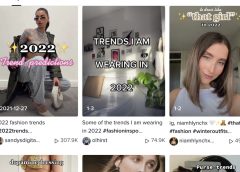
How TikTok took over fashion trends and the rise of “TikTok couture”
[ad_1]
Here is a list of fashion trends that, according to TikTok, are predicted to become a thing in 2022:
Balletcore, royalcore, regencycore, indie sleaze, 2014 soft grunge, twee, Russian bimbocore, “avant apocalypse” and its cousin dystopiacore, new Space Age, circa-2006 Diesel, balaclavas, clowncore, hyper Gen Z, bellhopcore, skirts over trousers, Missoni-Pucci resurgence, mod revival, “joycraft,” opera gloves, and feathers (just, like, in general).
This is a lot of trend for just one year. But I would argue that these are not all trends of their own accord: They’re all one trend, and that trend is TikTok couture.
What is TikTok couture? It is a (sort of rude) way to describe the coalescence of trends that materialize on TikTok, whether from teenagers experimenting with clothes they’ve thrifted from their local charity shop, from older folks revisiting the subcultural styles of their youth, or from professional and amateur trend watchers combining aesthetic clues into a single theory of what’s coming next. Together, with the help of the supercharged TikTok algorithm that blasts viral content to millions of users within hours or days, these videos shape what mainstream culture considers stylish, which therefore can affect what we choose to wear ourselves.
Consider TikTok couture the logical next phase of how social media has always influenced clothing. Throughout the 2010s, Instagram became the de facto mode of sharing one’s personal style and daily outfits, so much so that the platform itself affected shopping trends, what makeup we wore, and what kinds of plastic surgery procedures were in vogue. While Tumblr and Pinterest were tools for curating inspiration to define and explore one’s personal aesthetic, Instagram was meant for performing it.
TikTok, however, combines both in a single app: The personalized For You page is at once a gateway to exploring other people’s styles based on what the algorithm thinks you might like, and a way to remix those styles using tools like the duet, stitch, or comment reply features to add your own take. If TikTok has sensed you’re at all interested in fashion, it becomes the internet’s most up-to-date source of both inspiration and analysis — far more relevant than Pinterest, which tends to suffer from repetitiveness and monotony, and Instagram, which is too often determined by people you already know.
“Any time enough people on my TikTok feed are wearing one thing I’m like, ‘Well, that’s about to make a serious comeback,’” says Tessa, the 25-year-old, Hawaii-based creator behind one of YouTube’s best fashion criticism channels, ModernGurlz. She’s made several videos analyzing TikTok fashion, from the Y2K resurgence to more micro trends like “Twilightcore” and the “coconut girl.” When we spoke in October, she’d been seeing tons of outfits reminiscent of the 2003 film Thirteen, about two rebellious teenagers played by Nikki Reed and Evan Rachel Wood who wore low-rise flares, midriff-baring camis, and hoop earrings. “A lot of people, especially my age or older, freak out when they see these trends from middle school come back, but this is the natural progression. It’s how things work,” she explains.
No age group has ever had as much historical fashion knowledge and primary sources to draw from as young people do today, with the entirety of the last twenty years documented online. While the general rule in fashion is that trends and items begin to reappear after two decades, at this point teenagers — who were too young to participate the first time around and who are some of TikTok’s most ardent users — are already remixing styles that were popular just five or ten years ago, as is the case with the 2014 Tumblr aesthetic.
The ability to search beyond one’s own immediate surroundings for stylistic inspiration has, Tessa argues, made fashion far more accessible to teens. “If you like somebody’s style on TikTok, you can look up ‘grunge fairycore’ or whatever on Pinterest and find everything you need,” she says. “You can go into someone’s comment section on TikTok and ask them where they bought everything, and so TikTok aesthetics make their way to the general public because we have the ability to source all these pieces. Back in 2006, you wouldn’t have been able to go on Instagram and find every single item tagged in someone’s outfit — you’d have to look through a magazine or go to Macy’s and try your best.”
That accessibility has introduced a fervent new audience to fashion and, specifically, fashion criticism. Mandy Lee, one of the most popular trend forecasters on TikTok who goes by @oldloserinbrooklyn, told me in December that “In the last couple of months what I’ve noticed the most is that there’s way, way, way, way, way more fashion discourse created. Now it’s like, everyone’s a critic.” At this month’s Paris Fashion Week, Vogue reporter Steff Yotka noted how even as attendance to shows has seemed to decrease, the crowds outside have done the opposite. “As fashion’s influence grows, a new generation of fans is taking fashion-watching into their own hands,” she writes. “Powered by thriving fashion discourse on TikTok, Instagram, and Twitter, Millennial and Gen Z commentators are making the street scene the story.”
Young people have, to some degree, always set the tone for what’s considered cool, at least in the last seventy or so years since “teenagers” became an important spending category for marketers. But the rise of TikTok couture isn’t as simple as saying “young people are on TikTok, therefore TikTok decides what’s in vogue.” There’s a reason, for instance, that TikTok has declared not just a handful of but twenty-something aesthetics to be the next big thing in 2022: It’s because TikTok’s bread and butter is creating microtrends that flare up fast and die out faster. Whether or not they actually last (or exist in any meaningful way at all) is besides the point; as Kelsey Weekman notes in In the Know, “On TikTok, all it takes is one or two viral posts flaunting a certain aesthetic for the style to become a ‘microtrend.’” When I wrote about these kinds of “garbage trends” in December, I was referring to niche content cycles like “Couch Guy” and the fleeting fascination with sea shanties, but the same goes for fashion.
One of the first examples of how TikTok drove a quick-passing aesthetic trend was the coinage of the “VSCO girl” in 2019, which targeted teen girls who wore oversized T-shirts and carried around Hydroflasks. What wasn’t clear at the time, though, before the pandemic and before TikTok had calcified into the cultural powerhouse it is now, was that the VSCO girl aesthetic, along with its counterpart, the e-girl, were simply two branches of the same tree. It’s not necessarily that TikTok “invented” them, per se — many styles popular on TikTok got their names from Tumblr — but the TikTok machine packaged them into legible aesthetics, then elevated them to mainstream consciousness.
The pace of these microtrends now matches that of fast fashion, or what’s now known as “ultra-fast fashion,” where digital shopping platforms like Shein can design and produce new styles in a matter of days to reflect what’s trending online. When a certain style or product goes viral on TikTok, that item will often be sold out by the time the video is seen by the most amount of people, fueling in users a greater desire to discover TikTok trends as early as possible in an effort to get ahead of the cycle.
You can see how all of this might have some downsides for, you know, the economy-slash-environment-slash-general tenor of the culture. But while the immediate effect of the ephemerality of TikTok couture is the dizzying pace at which it moves online discourse, its real-life consequences are, if anything, sort of quaint.
Last fall I visited a vast, 500-acre sculpture garden in a quiet part of upstate New York, which involved hours of walking through hot, sun-drenched fields and damp dirt forest paths. Most people there were wearing what might be considered sensible attire for such an occasion, but three teenagers at the park stood out. One wore a ruffled collared shirt topped with a lace-up corset, a pleated plaid skirt and chunky heels, a look that was dominating my For You page at the time, another had dark hair framed by the bleached and pink-dyed tendrils stereotypical of e-girls. The third layered his shirts in the exact same way I’d seen fledgling fashion boys test out online. Seeing TikTok couture in the flesh, particularly in a space where it was least encouraged, I felt a warm affinity for the kids, who were experimenting with styles they’d undoubtedly seen countless times online, figuring out what fit with their own personalities and what didn’t.
There is something sort of beautiful about everything being in fashion at once, of the delicate wrap skirts of balletcore juxtaposed with the deconstructed surrealism of “avant apocalypse,” and the idea that no matter what a person puts on their body, they are weaving themselves within a tradition that extends far beyond the clothing itself. TikTok couture dregs up the surprising and fascinating and sometimes horrible history of fashion and all its complex context and lays it out for us to revisit at will. The trend cycle has never been faster, but perhaps style is only becoming more familiar.
This column was first published in The Goods newsletter. Sign up here so you don’t miss the next one, plus get newsletter exclusives.
[ad_2]
Source link


